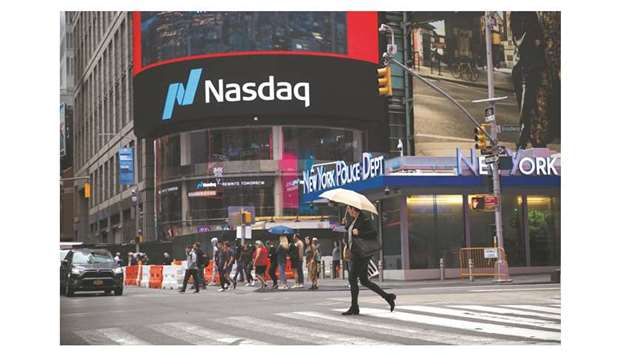When it comes to mixed messages from markets, 2019 has been a year with few precedents. Whenever a believable signal starts to emerge from stocks or bonds about the economy, it changes.
While some disagreement is normal, this is approaching the historic. For context, in a typical year, returns in either equities or Treasuries lead the other by 10 percentage points or more, reflecting a relatively firm consensus over whether growth will be good or bad.
But over the past 39 weeks, the two markets have been hugging each other like no time since the early 1990s, data compiled by Ned Davis Research show.
Bonds rally as the economic signal weakens, then sputter. Stocks go up on trade optimism, then fall.
That’s made it nearly impossible to fashion a macro thesis based on movements among assets.
“That’s the max frustration for investors and portfolio managers. There’s just no trend. It just disappears,” said Michael Antonelli, managing director and market strategist at Robert W Baird & Co, which oversees $285bn.
“People are changing their views about whether the economy is worsening or improving, and it seems to change by the week or day.”
How the disparity resolves has broad implications.
Because while markets may not know what’s going to happen, investors think they do. They’ve bet big on fixed income, sending $339bn into bond funds globally this year while pulling $208bn out of equities. Both are on pace for annual records, data compiled by Bank of America showed.
The “tug of war between stocks and bonds rages on,” Ned Davis strategists including Will Geisdorf wrote in a research note this week, noting it has wreaked havoc on one of their models that uses exchange-traded funds to allocate across asset classes.
The stock-bond return ratio has changed from being above or below its one-year average 11 different times this year, each instance triggering a 30% shift in the model’s equity-fixed income allocation.
To be sure, for anyone but day traders, the churn has had its happy aspects. The SPDR S&P 500 ETF Trust exchange-traded equity fund is up 21% including dividends in 2019, while the iShares 20+ Year Treasury bond ETF has risen 17%. Not since the bond fund’s 2002 inception have the two risen so far in lockstep – a sign of extreme conviction among both bulls and bears on the economy.
Complicating things further, indecision runs deep within the stock market itself. Defensive and cyclical shares have alternated leadership for five straight weeks, the longest stretch since December.
Most recently, the preference has been for risk. The S&P 500 rose for a second straight week. Meanwhile, selling in bonds sent 10-year Treasury yields toward 1.8%, a one-month high, as progress over Brexit and US-China trade and better-than-expected earnings outweighed weakness in economic data.
A group of cross-asset strategists at Commerzbank AG believes stocks will remain sensitive to good news. Positioning has also been extremely cautious all year and investors have piled into defensive industries like consumer staples and utilities, likely providing a floor for any stumble.
“Positive news flow is hyped, while negative data is mostly disregarded,” the strategists, including Florian Regnery and Heike Hauer, wrote to clients this week, noting they now prefer cheaper value stocks versus more expensive defensive ones for now.
“The fear of missing out on a possible cyclical rally and the lack of real alternatives has led to a massively asymmetric reaction function of equity markets.” Still, the S&P 500 hasn’t been able to hold above 3,000, and no other period since 1928 has seen stocks attempt a recovery from a 4% sell-off and fail so many times, according to Sundial Research. The fragile nature of the latest gains has left RBC Capital Markets straddled between cyclical and defensive sectors.
“It’s not entirely clear to us whether we’re at a turning point (on the cusp of pulling out of a growth scare and the range that the stock market’s been trapped in for the past two years) or at a tipping point (where the growth scare morphs into economic contraction),” said Lori Calvasina, the firm’s head of US equity strategy.
“We are keeping our over-weights balanced.” Hoping bonds can maintain their sheltering qualities may be misplaced, according to BofA strategists including Jared Woodard. Contrary to the perception that they offer stable returns and low risk, they’ve become jumpier, and the relationship between bond and equity returns is evolving.
Take Treasuries, for instance, securities usually seen as the safest part of a portfolio. Their pace of gains over six months is the fastest in eight years. But that’s come with extreme volatility.
In fact, if price swings are taken into account, its risk-adjusted returns trail all major assets but commodities during the past three years, BofA data showed. Over the stretch, the S&P 500 fared the best.
James Athey, a senior investment manager at Aberdeen Asset Management PLC, says the bond market is sending the message that central banks are trapped, and without further monetary stimulus, the economy can’t generate growth on its own.
The trend for economic growth is slower, and that’s a scenario in which yields can remain depressed.

A pedestrian is crossing the street in front of the Nasdaq MarketSite in New York (file). Over the past 39 weeks, stocks and bonds markets have been hugging each other like no time since the early 1990s, data compiled by Ned Davis Research show.


